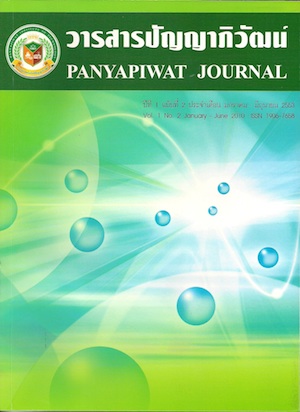วัฒนธรรมความปลอดภัย: ปัจจัยเชิงบูรณาการเพื่อความสำเร็จอย่างยั่งยืนขององค์การ
Main Article Content
บทคัดย่อ
บทคัดย่อ
อุบัติเหตุจากการทำงานนำมาซึ่งความสูญเสียอย่างมากมายต่อองค์การ จึงเป็นที่ตระหนักดีทั้งภาครัฐและภาคเอกชนที่พยายามดำเนินการป้องกันไม่ให้อุบัติเหตุเกิดขึ้น โดยการพยายามที่จะออกกฎหมาย กฎระเบียบ หรือหาระบบการจัดการด้านความปลอดภัยนำมาใช้ในองค์การ ปัจจุบันวัฒนธรรมความปลอดภัย ซึ่งก็คือ ความคิด ความเชื่อที่ถูกฝังแน่นของกลุ่มคนในองค์การจนถูกนำมาใช้เป็นแนวทางการปฎิบัติของคนในองค์การเองโดยไม่จำเป็นต้องมีลายลักษณ์อักษร ถูกนำมาพิจารณาเป็นแนวทางหลักในการบริหารจัดการองค์การ การสร้างวัฒนธรรมความปลอดภัยที่ดีอาจทำได้โดยการบูรณาการการบริหารองค์การด้านความปลอดภัย เพื่อสร้างวัฒนธรรมความปลอดภัย ตั้งแต่ระดับ องค์การ กลุ่ม จนถึงปัจเจกบุคคล โดยมีปัจจัยที่เป็นองค์ประกอบดังนี้ 1)เจตจำนงค์ของผู้บริหารที่มีต่อความปลอดภัย 2) การสื่อสารด้านความปลอดภัย 3) ขีดความสามารถด้านความปลอดภัย 4) ความร่วมมือของบุคลากรด้านความปลอดภัย 5) ความรับผิดชอบของบุคลากรด้านความปลอดภัย โดยทั้งหมดจะถูกสร้างกรอบมาจากระบบการจัดการความปลอดภัยขององค์การที่มีอยู่ เมื่อองค์การสามารถที่จะสร้างวัฒนธรรมความปลอดภัยได้แล้วจะทำให้สมาชิกขององค์การตรวจสอบ และควบคุมกันเอง นำมาซึ่งความปลอดภัยในองค์การ อันมีผลต่อภาพพจน์ ผลิตภัณฑ์และชื่อเสียงขององค์การ อันเป็นการแสดงความรับผิดชอบต่อสังคม และส่งผลต่อความสำเร็จอย่างยั่งยืนขององค์การ
คำสำคัญ : วัฒนธรรมความปลอดภัย, การบริหารจัดการความปลอดภัย
Abstract
Accident brings tremendous loss to the organization. Both of Public and Private sectors aware and try to prevent it occurred. They attempt to regulate by issue the legislation, regulation and implementation of safety management systems. At the present, safety culture which is think and believe that imbedded in member of organization that used to be operational guideline by do not write to be procedure. It is considered to primary approach for administration in organizations. The best of safety culture should be integrated in the way of organization management and build it from organization, group and individual levels. The component factors are as follows: 1) management commitment to safety 2) safety communication 3) safety competency 4) safety coordination of employees and 5) safety responsibility of employees. The existing safety management system is to be the frame of all. Safety culture is the way of members in organization can audit and control themselves. It brings to the best of safety operation which affect to brand and organization’s image. It is demonstrated to corporate social responsibility and sustainable success of organization.
Keywords : Safety culture, safety management
Article Details
“ข้าพเจ้าและผู้เขียนร่วม (ถ้ามี) ขอรับรองว่า บทความที่เสนอมานี้ยังไม่เคยได้รับการตีพิมพ์และไม่ได้อยู่ระหว่างกระบวนการพิจารณาลงตีพิมพ์ในวารสารหรือแหล่งเผยแพร่อื่นใด ข้าพเจ้าและผู้เขียนร่วมยอมรับหลักเกณฑ์การพิจารณาต้นฉบับ ทั้งยินยอมให้กองบรรณาธิการมีสิทธิ์พิจารณาและตรวจแก้ต้นฉบับได้ตามที่เห็นสมควร พร้อมนี้ขอมอบลิขสิทธิ์บทความที่ได้รับการตีพิมพ์ให้แก่สถาบันการจัดการปัญญาภิวัฒน์หากมีการฟ้องร้องเรื่องการละเมิดลิขสิทธิ์เกี่ยวกับภาพ กราฟ ข้อความส่วนใดส่วนหนึ่งและ/หรือข้อคิดเห็นที่ปรากฏในบทความข้าพเจ้าและผู้เขียนร่วมยินยอมรับผิดชอบแต่เพียงฝ่ายเดียว”
เอกสารอ้างอิง
ทิพวรรณ หล่อสุวรรณรัตน์. (2547). ทฤษฎีองค์การสมัยใหม่. พิมพ์ครั้งที่ 5. กรุงเทพฯ: แซทโฟร์พริ้นติ้ง.
Antonsen Stain. (2009). Safety culture and the issue of power. Safety Science, 47(2), 183-191.
Clarke, S. G. (2000). Safety culture: Under-specified and overrated?. International Journal of Management Reviews, 2(1), 65-90.
Cooper, M. D. (2002). Safety culture: A model for understanding & quantifying a difficult concept. Professional Safety, June, 30-36.
Flin, R., Mearns, K., O’Connor, P., Bryden R. (2000). Measuring safety climate: Identifying the common features. Safety Science, 34(1-3), 177-192.
Frank E. Bird, Robert G. Loftus. (1976). Loss Control Management. Loganville, GA: Inter-national Loss Control Institute.
Guldenmund, F.W. (2000). The nature of safety culture: A review of theory and research. Safety Science, 34(1-3), 215-257.
Harvey, J., Bolam, H., Gregory, D., & Erdos, G. (2001). The effectiveness of training to change safety culture and attitudes in a highly regulated environment. Personel Review, 30(5/6), 615-636.
Health and Safety Executive. (2005). A review of safety culture and safety climate literature for the development of the safety culture inspection toolkit. London: HSE.
Heinrich, H. W. (1931). Industrial accident prevention. 1st Ed. New York, McGraw-Hill.
International Atomic Energy Agency. (1991). Summary report on the post-accident review meeting on the Chernobyl accident. Vienna: IAEA.
Reber, R.A., & Wallin, J.A. (1994). Utilizing performance management to improve offshore oilfield driving safety. The International Journal of Organizational Analysis, 2(1), 88-98.
Schein, E.H. (1985). Organizational culture and leadership: A dynamic view. San Francisco: Jossey-Bass Publishers.
Smircich, L. (1983). Concept of culture and Organization Analysis. Administrative Science Quarterly, 28, 339-338.
U.S. Department of Labor. (2010). Safety Culture. Retrieved May 24, 2010, http:// http://www.dol.gov/
Warrack, B.J. & Sinha, M.N. (1999). Integrating safety and quality: Building to achieve excel-lence in the workplace. Total Quality Manage-ment & Business Excellence, 10(4/5), 779-785.


